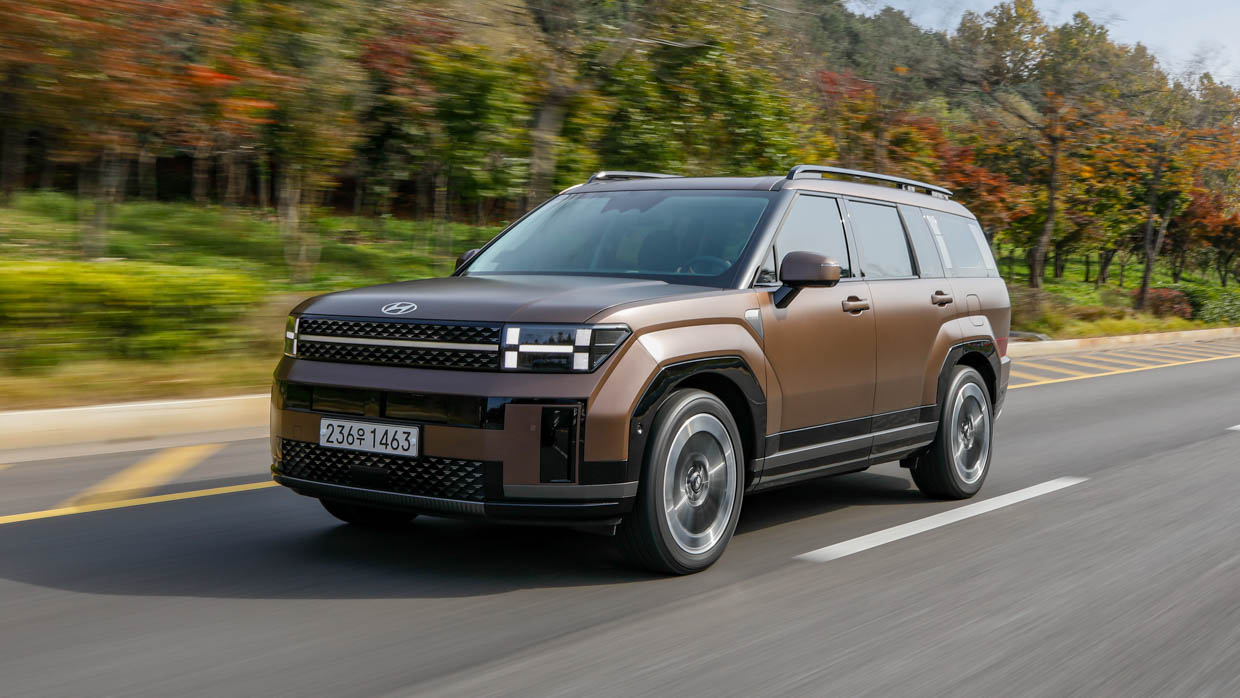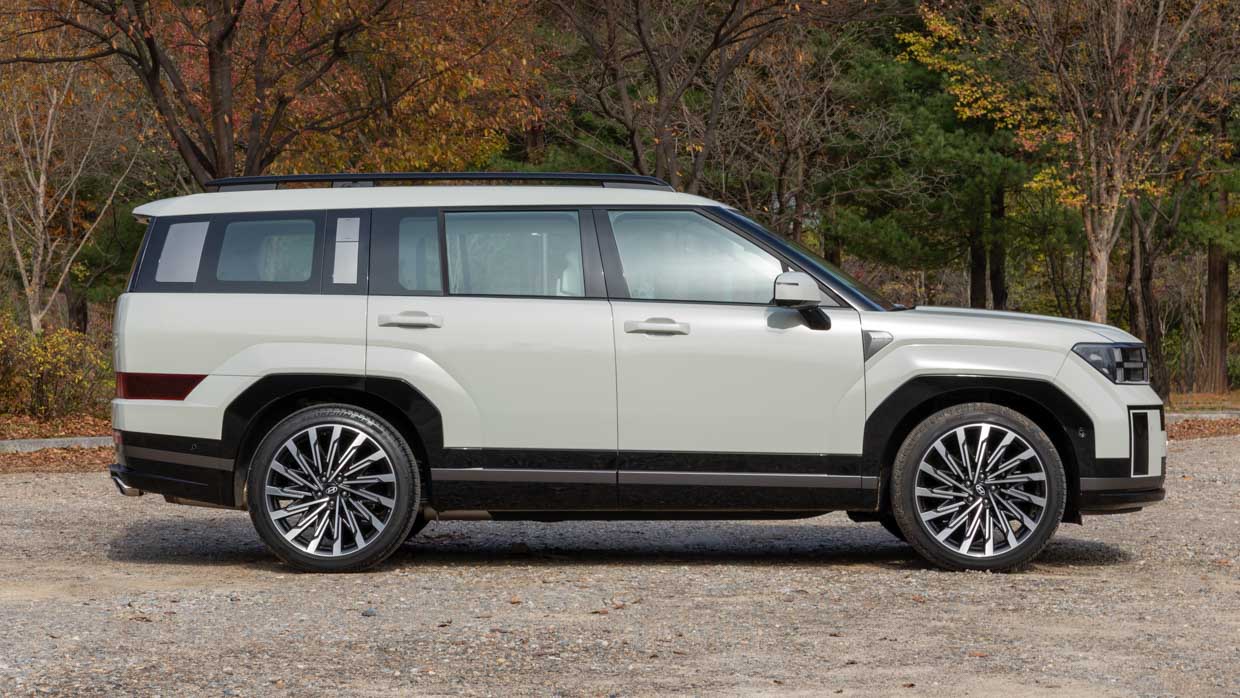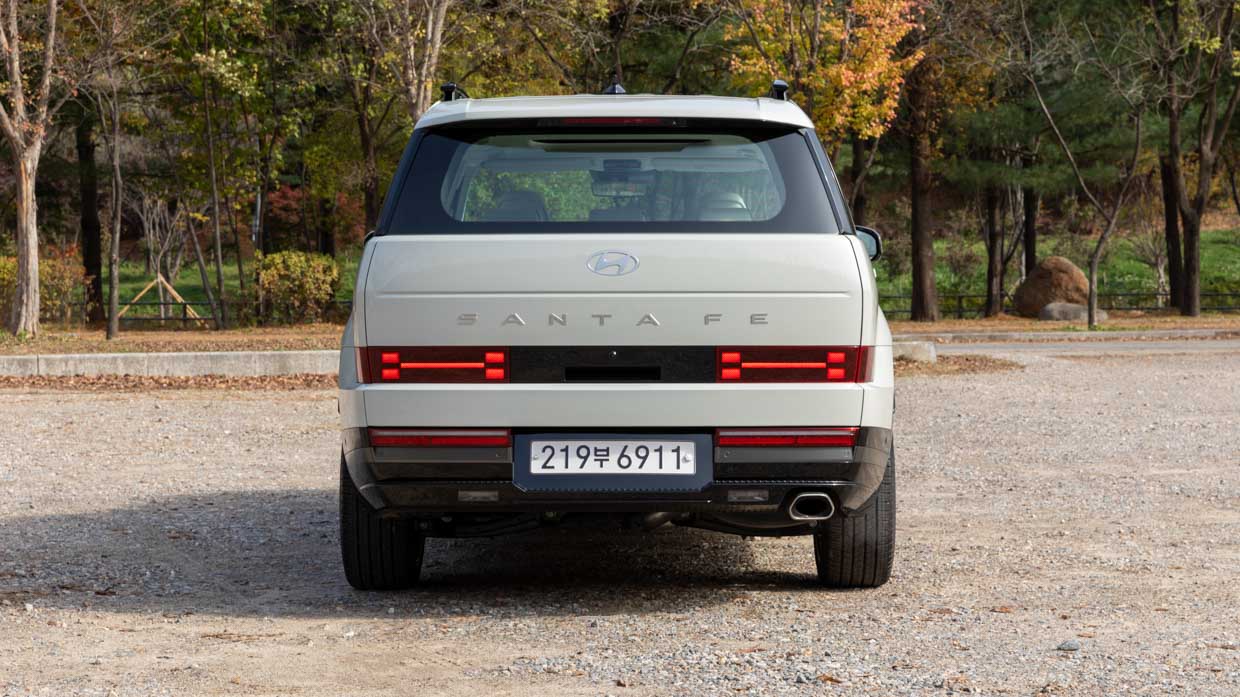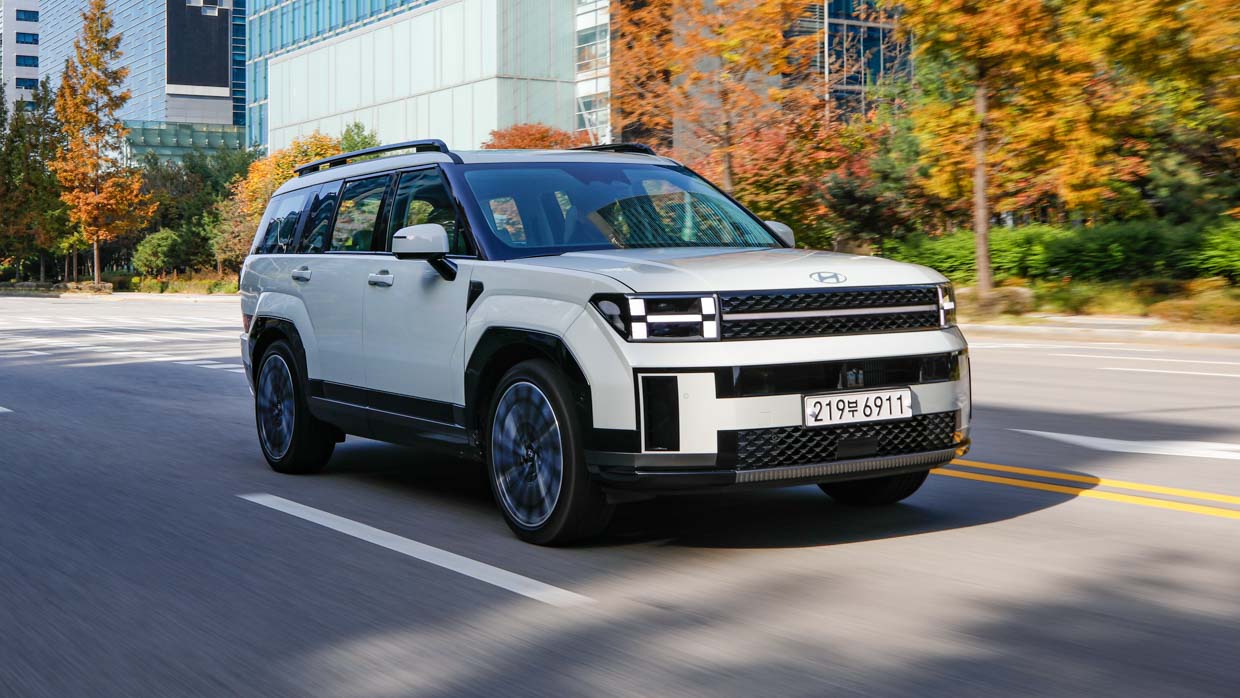-
Car Reviews
- All reviews
- Midsize SUVs
- Small cars
- Utes
- Small SUVs
- Large SUVs
- Large cars
- Sports SUVs
- Sports cars
- Vans
Latest reviews
- Car News
-
Car Comparisons
Latest comparisons
- Chasing Deals
A bold and boxy design accompanies a totally revised and larger fifth-generation Hyundai Santa Fe, but will Australians warm to this seven-seat SUV?
Despite the headlines, there’s much more to the 2024 Hyundai Santa Fe than its controversial rump.
This fifth-generation large SUV has attracted more attention in the bum department than an Olympic beach volleyball final, but we can’t let this totally distract from the merits of what’s shaping up to be a true standout in the seven-seat segment.

Ahead of its Australian launch – possibly as early as April 2024 – we tested the new-gen Santa Fe in South Korea. The model’s already on the roads out there, where its polarising styling and often striking colours help it stand out amongst the monochrome traffic.
Positively, we were given plenty of time to drive the Santa Fe over hundreds of kilometres, explore its roomier cabin and sample its new tech and features for this review. And we’ve come away highly impressed.
More opaque, sadly, are full details on specification for Australia, which powertrains we’ll receive, when they’ll arrive, or pricing details. Initially, a driveaway price from $60,000 – around $5000 above the current Santa Fe – seems a fair guess.

Sticking to the knowns, from launch Australia will receive one model: a seven-seat, all-wheel-drive version using a 1.6-litre turbocharged petrol hybrid with six-speed automatic.
It’s likely to be the same 169kW/350Nm (combined) unit seen in the current Santa Fe, although there may be some engine tweaks for the 2024 car.
Highly likely to follow is a punchier (and thirstier) non-hybrid 207kW/422Nm 2.5-litre turbo petrol with eight-speed dual clutch auto, as seen in Hyundai’s Sonata sedan.
The RHD UK market’s also launching with a plug-in hybrid, but there’s no word if or when we’ll get it. There’s also no suggestion of a full-electric version – Hyundai’s incoming Ioniq 7 should cover that base.

Missing in action are the current Santa Fe’s V6 petrol and, crucially, a diesel. The latter currently makes up some 70 percent of Santa Fe sales: its favourable economy, all-wheel drive and low-down torque preferred by we Aussies.
The new hybrid powertrain goes some way to plug the gap, but not if you’re planning to tow. The current diesel Santa Fe can lug 2500kg braked, but this hybrid can manage just 1650kg – a deal-breaker for some. It’s unlikely we’ll ever see a diesel in the new Santa Fe, though it’s not been wholly ruled out.
Size wise, the 2024 Santa Fe is longer, taller and its wheelbase has been extended by 50mm over the outgoing model. The latter’s there to address a common gripe that third-row seating’s too cramped.

You know what else has been addressed? The Santa Fe’s too vanilla styling. And I think that must be celebrated. Hyundai’s championed properly bold design in recent years – Kona, Ioniq 5, Ioniq 6 and i30 sedan included – and this new SUV’s adventurous boxy shape is a welcome break from convention.
Sure, there are shades of Land Rover Defender, and the new Toyota Prado’s designer may have shared a beer and sketches with whoever penned the new Santa Fe. But in the metal this big Hyundai’s eye-catching, imposing and, from most angles, ruggedly attractive.
I got used to the polarising back end. The oblong lights with H-pattern LEDs wrap around the side of a squared off rear and it looks superb at night.
I worry the indicators and reverse lights are mounted too low, and its tapered-in base somehow makes this hulking SUV look too skinny and at times awkward from behind.

The giant, near straight-sided tailgate is akin to a minivan, and after hours of following one, settled on the thought that the slanted rear does remind of an early Lada Niva or late-’70s British Leyland Princess. You may need to Google them, kids.
The front features signature H-pattern headlights – I like the almost Space Invaders design nod – to go with the overall retro-like boxiness. Wheel arches are extrovertedly pronounced, meaning even the 21-inch alloys on our range-topping tester looked small in there.
We’ll have to wait a few months before Australian trims and spec are known, but it’s likely there’ll be a three-grade lineup as seen with the new generation Kona.
Think Santa Fe (basic), Premium then something higher again. An N Line option pack? We’ll have to wait and see.

A rugged Santa Fe XRT off-roader was shown at the LA Auto show earlier this month with black styling, higher ride height and all-terrain tyres. Apparently it’s for the North American market only, but again, don’t rule it out for us eventually.
Hyundai’s had to up its game if it wants to play catch up to the Toyota Kluger, Kia Sorento and new Nissan Pathfinder, and it claims its comfort and convenience features are “world’s first, first-in-class or class-leading” for the new Santa Fe.

Features – although which grade they’ll come on is unknown – include:
Colour choice should be as interesting as the new Santa Fe’s styling. Highlights include an Ocado green pearl, Terracotta orange or – to really make your mark – an earthy brown matte metallic. Let’s hope these all come to Australia.
The usual whites, blacks, silvers and greys also feature, but stuff these resale specials and embrace the bold instead.
Those who eschew this new Santa Fe if they can’t abide its looks will miss out on one of the best all-rounders in the large SUV segment.
Quiet and efficient in urban areas, then surprisingly balanced, composed and safe-feeling along twisting country lanes. The hybrid we’re getting is a lardy 2225kg – surprisingly heavy – but it only really feels as much if you play at tight corner heroics. Santa Fe owners won’t often do this.

Its poor towing capacity aside, this hybrid powertrain absolutely feels correct for Australians in 2024. I have many friends and acquaintances who own the current Santa Fe (it’s a popular choice in school car parks), and there’s never a tow bar to be seen.
They crave economy in these cost-of-living-crisis times, and Hyundai’s hybrid system feels the match of Toyota’s highly accomplished and economical offerings.
At city speeds – the typical urban crawl – it whispers along on battery power alone. Stay gentle on the throttle and the petrol engine remains dormant – I managed over 50km/h before it decided to chime in.
When it did, its entry was near imperceptible. The way the 1.6-litre turns off and on in such a quiet manner means you soon forget it’s a hybrid. The well cosseted cabin helps, but rest assured there’s no vulgar, disturbing combustion shake when the petrol drinking begins.

Pin the throttle and of course there’s more noise, but the six-speed torque-converter auto handles changes smoothly, and although some may prefer extra cogs, its smooth, unfussed nature seemed ample from my leathery seating position.
In town I was seeing exactly 6.0L/100km, although I was aiming for ultimate eco driving. Even so, this return for such a weighty SUV is excellent. For Santa Fe drivers whose typical journeys are school runs and city commutes, you really won’t miss the old 3.5-litre V6’s heavy drinking figures.
I’d conservatively say this hybrid will cut those fuel bills in half.
The trade-off is that the engine lacks any meaningful shove. It doesn’t reach 100km/h for 9.5 seconds, and there’s certainly not the eager torque of a typical turbo-diesel. But there’s enough low speed zip from the petrol/electric combo once you’re rolling, and it never feels less than fit for urban life purpose.

We also sampled the 2.5-litre turbo petrol, this model being 70kg lighter and reaching 100km/h in a more modern feeling eight seconds flat. It feels a brawny unit with decent response through its eight-speed DCT auto.
The turbo petrol made for more enjoyable progress out in the country, but couldn’t match the hybrid’s smoothness and certainly its economy in town. Our overall fuel use – over a few hundred kilometres of highway, back roads and city – was 9.5L/100km.
Engines aside, Hyundai’s done a sterling job with ride comfort and cabin quiet here. Yes we were in Korea’s range-topping variant flush with luxe, but the drive experience felt impressively premium. Hyundai and Korea have truly taken the fight to prestige brands here.

Our flagship Santa Fe rolled on 21-inch alloys with quite low profile tyres, but even over choppy ground, the ride quality impressed. Bumps were well absorbed and it settled with poise, and I’d suspect lesser grades on smaller wheels with thicker tyres will be better again.
No doubt Hyundai’s Australian engineers will evaluate ride quality for our market, but first impressions suggest they won’t need to go revolutionary.
On highways it’s superb, and even on rural twisties it didn’t disgrace, despite that weight. No, it’s not what you’d call agile, but body roll’s well kept at bay, it handles neatly and there’s impressive grip for such a unit.
There’s a much cleaner, smarter dash design versus the old Santa Fe, with the ‘H’ pattern theme continued across air vents and dashboard. It looks and feels excellent.
The panoramic curved display’s a standout, with a brace of 12.3-inch screens incorporated – one for the driver display, the other for infotainment. In typical no-nonsense Hyundai fashion, it’s nicely designed for easy navigation, with just enough customisation to tailor your preferences.


Taking inspiration from electric cars and their (usual) abundance of centre console space, the gear selector has been relocated to the steering column, freeing up room for two wireless phone charge pads.
There are two USB-C ports here too, and while wired Apple CarPlay and Android Auto may be the go from launch, hopefully the Santa Fe’s ability for over-the-air updates will mean wireless isn’t far away.
There are massive cup holders, a central storage bin with slide-out section so those in the middle seats can pinch your stored snacks (or Dad’s wallet), and a large open tray beneath the charge pads. With decent door bins too, it’s been brilliantly thought out with modern family life at the fore.


Kudos for retaining proper climate knobs alongside a 6.6-inch climate control display, while innovations include so-called ‘Relaxation’ seats up front, where a leg rest electrically rises for a more business class recline feel.
I hope we get some different dash trim options, as our test cars featured bamboo-like finishes, one being a bit too zebra-like for me. A real slice of ash wood instead would really up the prestige feel.
Meanwhile, a UV-C sterilisation tray feels like frippery gone too far. It’s found above the glovebox, and is there to sterilise the likes of a mobile phone or wallet with a blast of UV. It’s a bit OCD overkill – give me a chiller box instead please.

The middle-row seats bring vast space – head and leg room – and they slide on runners for greater versatility. The seat base and seat backs aren’t sink-in comfy, but seat backs recline and the centre armrest is deeply padded.
More USB-Cs and air vents are found in the middle row, and the twin glass roof – where fitted – doesn’t encroach on headroom, and adds welcome light for passengers.
Slide the middle seats forward and the third row passes as seating for adults. Hyundai claims its two rearmost seats offer the best space in class, and that longer wheelbase has certainly worked wonders for these two back chairs.

My 180cm frame tolerated it here, but still won’t match a Hyundai Palisade, or the brilliant Kia Carnival.
But the backrests recline, there are USB-C ports, bottle holders and a domestic socket, so you’re not third-class in the third-row. Access into back seats is well thought out with simple-use handles.
The massive tailgate auto rises to expose a 725L boot with five seats in place, and even with seven up, there’s enough room for a decent grocery shop.

Fold both rows of seats (using smart handles) and they go fully flat. Hyundai is promoting the outdoor life, glamping-type potential of the new Santa Fe, and its images look convincing with the boot’s massive aperture and sweeping vistas.
More realistically, it looks possible to fit a blow-up double mattress in there, and such is the length of this vehicle it looks comfy for an overnight. With the domestic socket point, running a small air con unit or heater would make things comfier again.
Again, final specification for Australia is yet to be revealed, but the following safety systems are in the new Santa Fe, and will hopefully be standard across all models.
Our lengthy drive was pleasingly free of over-nannying. Hyundai’s current Satna Fe lane keep assist or lane centring is too beepy and quick to correct in many of its current cars, spoiling the drive. But the new Santa Fe’s system felt better calibrated, the nannying less strict and the steering corrections to lane centre were less invasive.
We’ll have a clearer picture closer to launch, but the hybrid’s economy is quoted at 6.5L/100km. That’s up from the current hybrid’s 6.0L/100km.
Warranty is five-years/unlimited kilometres – average for the industry – while the high-voltage (hybrid) components have an eight-year/160,000km warranty.

We’d expect servicing over five years to be north of $2500, or roughly double that of Toyota’s incredibly cheap capped price services for its rival Kluger Hybrid. We’ll see the truth at the Aussie launch.
When the 2.5-litre turbocharged petrol Santa Fe arrives (as we expect it to), combined economy will likely be 9.0L/100km. That’s a welcome 1.5L/100km improvement over the outgoing petrol V6.

No front-wheel-drive or five-seat Santa Fe has been confirmed for our market, so the initial purchase price will be a fair whack higher than the current entry-level V6 Base petrol front-drive Santa Fe.
Expect the entry-level 2024 Santa Fe Hybrid to start from around $54,000, so roughly $60,000 on the road. The top grade, we’d suspect, will eclipse $80,000 to drive away.
This was just a first sample of the 2024 Santa Fe, and without knowledge of the price or specification we’ll receive in Australia.
Regardless, it’s obvious this is a standout seven-seat SUV. Ride quality, cabin class and smart tech, comfort and layout make it a truly covetable family car.

The petrol-hybrid drivetrain feels like the correct choice for Australia in 2024 – its smoothness and economy really impress. Even so, the gruntier 2.5-litre turbo petrol can’t come soon enough for buyers demanding more guts and towing capacity – especially with no diesel offered.
But perhaps the Santa Fe’s success depends on how well the market accepts its polarising design.
Bold styling can be the undoing of many a good car, but I reckon Hyundai’s timed this boxy SUV to perfection – retro shapes and a break from the norm is tapping into the zeitgeist. If Aussies are ready, it’ll sell like hot cakes.
About Chasing cars
Chasing Cars reviews are 100% independent.
Because we are powered by Budget Direct Insurance, we don’t receive advertising or sales revenue from car manufacturers.
We’re truly independent – giving you Australia’s best car reviews.
The estimate provided does not take into account your personal circumstances but is intended to give a general indication of the cost of insurance, in order to obtain a complete quote, please visit www.budgetdirect.com.au. Estimate includes 15%^ online discount.
^Conditions Apply
Budget Direct Insurance arranged by Auto & General Services Pty Ltd ACN 003 617 909(AGS) AFSL 241 411, for and on behalf of the insurer, Auto & General Insurance Company Limited(ABN 42 111 586 353, AFSL 285 571).Because we don’t know your financial needs, we can’t advise you if this insurance will suit you. You should consider your needs and the Product Disclosure Statement before making a decision to buy insurance. Terms and conditions apply.
Indicative quote based on assumptions including postcode , 40 year old male with no offences, licence suspensions or claims in the last 5 years, a NCD Rating 1 and no younger drivers listed. White car, driven up to 10,000kms a year, unfinanced, with no modifications, factory options and/or non-standard accessories, private use only and garaged at night.
^Online Discounts Terms & Conditions
1. Discounts apply to the premium paid for a new Budget Direct Gold Comprehensive Car Insurance, Third Party Property Only or Third Party Property, Fire & Theft Insurance policy initiated online on or after 29 March 2017. Discounts do not apply to optional Roadside Assistance.
2. Discounts do not apply to any renewal offer of insurance.
3. Discounts only apply to the insurance portion of the premium. Discounts are applied before government charges, taxes, levies and fees, including instalment processing fees (as applicable). The full extent of discounts may therefore be impacted.
4. We reserve the right to change the offer without notice.